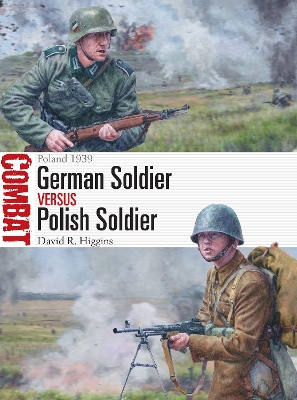Combat
2 total works
The Nazi invasion of Poland in September 1939 saw mostly untested German troops face equally inexperienced Polish forces. With the Polish senior leadership endeavouring to hold the country’s industrialized east, Hitler’s forces unleashed what was essentially a large pincer operation intended to encircle and eliminate much of Poland’s military strength. Harnessing this initial operational advantage, the Germans were able to attack Polish logistics, communications and command centres, thereby gaining and maintaining battlefield momentum. With the average infantry soldier on both sides comparatively well-led, equipped and transported, vital differences in battlefield support (especially air power and artillery), tactics, organization and technology would make all the difference in combat.
Featuring specially commissioned artwork, archive photography and battle maps, this study focuses upon three actions that reveal the evolving nature of the 1939 campaign. The battle of Tuchola Forest (1–5 September) pitted fast-moving German forces against uncoordinated Polish resistance, while the battle of Wizna (7–10 September) saw outnumbered Polish forces impede the German push north-east of Warsaw. Finally, the battle of Bzura (9–19 September) demonstrated the Polish forces’ ability to surprise the Germans operationally during a spirited counter-attack against the invaders. All three battles featured in this book cast light on the motivation, training, tactics and combat performance of the fighting men of both sides in the 1939 struggle for Poland.
Featuring specially commissioned artwork, archive photography and battle maps, this study focuses upon three actions that reveal the evolving nature of the 1939 campaign. The battle of Tuchola Forest (1–5 September) pitted fast-moving German forces against uncoordinated Polish resistance, while the battle of Wizna (7–10 September) saw outnumbered Polish forces impede the German push north-east of Warsaw. Finally, the battle of Bzura (9–19 September) demonstrated the Polish forces’ ability to surprise the Germans operationally during a spirited counter-attack against the invaders. All three battles featured in this book cast light on the motivation, training, tactics and combat performance of the fighting men of both sides in the 1939 struggle for Poland.
In 1967-68, the United States Marine Corps (USMC) was on the front line of the defence of South Vietnam's Quang Tri province, which was at the very heart of the Vietnam conflict. Facing them were the soldiers of the North Vietnamese Army (NVA), men whose organization and equipment made them a very different opponent from the famous, irregular Viet Cong forces. From the 'Hill Battles' in April 1967 to the struggle for the city of Hue (January-March 1968) this bloody campaign forced the two sides into a gruelling trial of strength. The USMC held a general technological and logistical advantage - including close air support and airborne transport, technology, and supplies - but could not always utilize these resources effectively in mountainous, jungle, or urban environments better known by their Vietnamese opponents. In this arresting account of small-unit combat, David R. Higgins steps into the tropical terrain of Vietnam to assess the performance and experience of USMC and NVA forces in three savage battles that stretched both sides to the limit.

